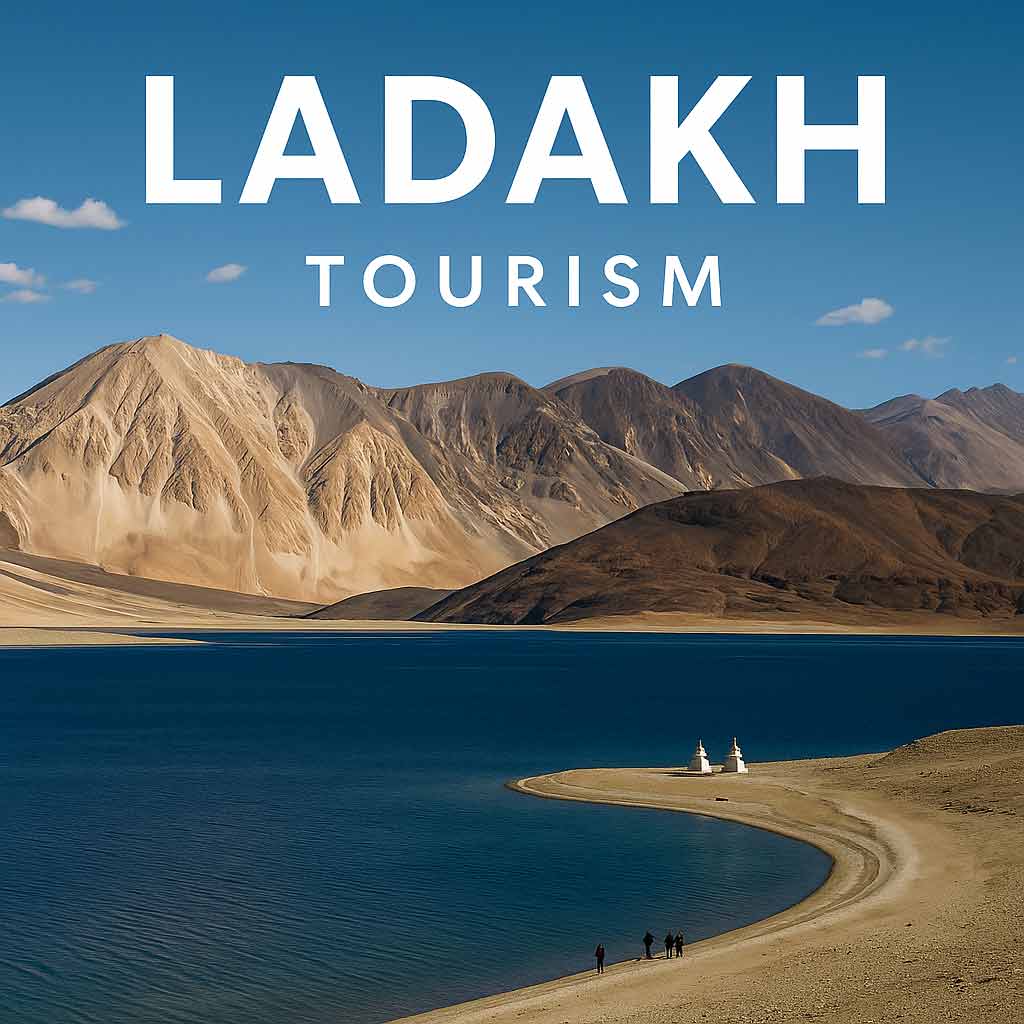Ladakh – Jammu & Kashmir
– The Land of High Passes

Ladakh Tourism – The Land of High Passes
Perched high in the Himalayas, Ladakh, often called the “Land of High Passes,” is one of India’s most spectacular and surreal destinations. Nestled between the Karakoram and Himalayan mountain ranges, this union territory offers a landscape so dramatic that it seems otherworldly — barren mountains streaked with color, crystal-clear lakes, ancient monasteries, and vast skies that stretch endlessly above.
Located at an altitude ranging from 9,000 to 25,000 feet, Ladakh is not just a place; it’s an experience that touches your soul. With its pristine beauty, unique Buddhist culture, and thrilling adventures, it stands as a crown jewel of India’s northern frontier.
A Landscape Beyond Imagination
Ladakh’s beauty is raw, vast, and breathtaking. The region’s high-altitude desert terrain, sculpted by wind and time, is dotted with emerald valleys, glacial streams, and rugged mountain passes. Every curve on its winding roads reveals a new panorama — from the golden mountains of Lamayuru, often called “Moonland,” to the turquoise expanse of Pangong Lake, whose waters change color with the shifting light.
Equally captivating is Tso Moriri, a high-altitude lake surrounded by snow peaks, and Nubra Valley, a cold desert where sand dunes coexist with the gentle flow of the Shyok and Nubra rivers. The Khardung La Pass, one of the highest motorable roads in the world, offers breathtaking views that leave travelers awestruck.
For those seeking solitude and spiritual calm, Ladakh’s serene beauty is meditative — a reminder of nature’s power and peace.
Culture and Spirituality
Ladakh is deeply rooted in Tibetan Buddhism, evident in its architecture, festivals, and daily life. The region is adorned with ancient monasteries (gompas) perched on cliffs, their whitewashed walls contrasting beautifully with the surrounding brown mountains.
The Hemis Monastery, the largest and wealthiest in Ladakh, comes alive during the Hemis Festival, where masked dances, vibrant costumes, and rhythmic chants celebrate the triumph of good over evil. Other must-visit monasteries include Thiksey, Diskit, Alchi, and Spituk, each offering spiritual solace and a glimpse into centuries-old Buddhist traditions.
Colorful prayer flags flutter in the mountain winds, symbolizing peace and compassion. The locals — warm, humble, and deeply connected to their land — live in harmony with nature, reflecting the Buddhist philosophy of simplicity and mindfulness.
Adventure in the Himalayas
For adventure enthusiasts, Ladakh is a playground like no other. Its rugged terrain and challenging altitudes attract trekkers, bikers, and thrill-seekers from across the globe. The Markha Valley Trek, Chadar Trek (on the frozen Zanskar River), and Stok Kangri climb are among the most famous expeditions in India.
Motorcyclists dream of conquering the Manali-Leh Highway or the Srinagar-Leh route, both offering adrenaline-pumping drives through hairpin bends, roaring rivers, and snow-covered passes. For cyclists, the Khardung La challenge is an ultimate test of endurance.
Adventure also takes quieter forms here — from rafting in the icy Zanskar River to camping under a canopy of a million stars, Ladakh offers thrills for every soul, whether daring or contemplative.
A Region of Living Heritage
Beyond its mountains and monasteries, Ladakh is a region of living culture. Traditional mud-brick houses, vibrant markets in Leh, and the rhythmic beats of Ladakhi music bring life to its high-altitude towns. The cuisine — from thukpa (noodle soup) and momos to butter tea — reflects a blend of Tibetan and Indian flavors, perfect for warming up in the cool mountain air.
Festivals like Losar, Ladakh Festival, and Yuru Kabgyat fill the valleys with music, dance, and color, offering travelers a chance to connect deeply with Ladakh’s spirit of joy and community.
Best Time to Visit and Travel Tips
The best time to visit Ladakh is from May to September, when the roads are open, and the weather is pleasant. During these months, the region transforms into a paradise for photographers and adventurers alike. Winter, though harsh, reveals a quieter side of Ladakh — frozen rivers, snow-clad monasteries, and endless silence.
Travelers are advised to acclimatize gradually to the high altitude, stay hydrated, and respect local customs and the fragile mountain environment.
Conclusion
Ladakh is more than just a destination — it’s a journey to the roof of the world, a place where nature, spirituality, and adventure blend seamlessly. From the shimmering blues of Pangong Lake to the chants echoing through ancient monasteries, every moment here is poetry in motion.
In Ladakh, one doesn’t just witness beauty — one feels it, breathes it, and carries it forever. Truly, it’s a land where heaven meets earth — a timeless adventure for the heart and soul.
